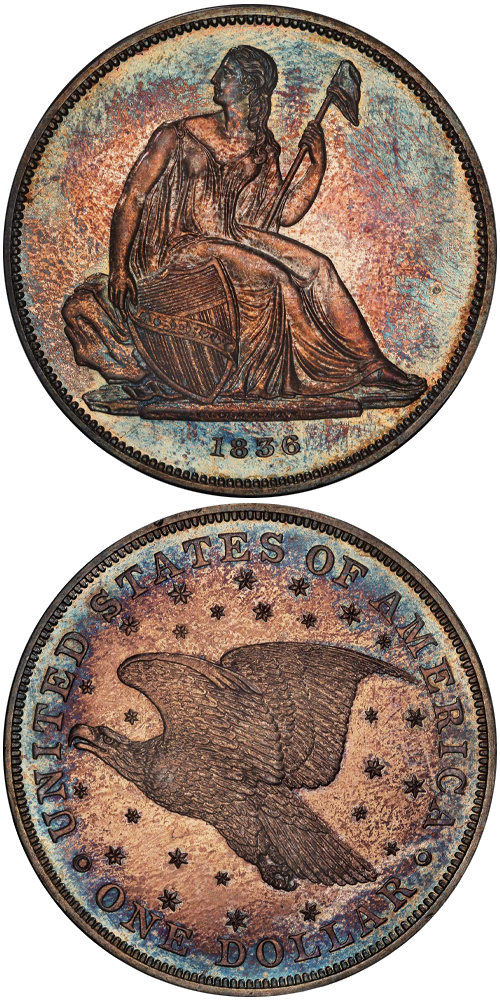1836 Gobrecht Dollar
Judd-60
Since dollar production was suspended in 1804, the silver dollar denomination had become unfamiliar in commerce in the decades preceding 1836, though Spanish 8 reales and other world coins of silver dollar size continued to circulate throughout the United States. In 1831, when the tide of bullion outflows to the Far East began to make the market for a domestically circulating dollar coin possible again, the ban on dollar production was lifted and the possibility of a dollar coin was reconsidered. With engraver William Kneass in poor health, the Mint was forced to wait until after the June 1835 appointment of Christian Gobrecht as assistant or "second" engraver. Gobrecht received design assistance from two of America's best-known painters, Thomas Sully, who offered sketches of a seated figure of Liberty with cap and pole, and Titian Peale, who submitted several sketches of a "naturalistic eagle" whose flight was described by Mint Director Robert M. Patterson as "like the country of which it is the emblem, its course onward and upward." Gobrecht refined Sully's concept for the obverse and Peale's concept for the reverse, to which he added 26 stars, 13 large ones for the original colonies and 13 smaller ones for subsequent states, apparently anticipating the January 1837 entry of Michigan to the Union.
Dating Gobrecht dollars hinges upon their die alignment and die state. The original strikings in 1836 were struck in Die Alignment I, standard coin turn with the eagle pointing upward. The head of Liberty is opposite DO of DOLLAR. In this alignment, the pellet preceding ONE, on the left side of the reverse, is on a slightly lower plane than the pellet following DOLLAR on the right side of the reverse. The die state is equivalent to Dannreuther-Teichman-Sholley State H, showing the peripheral die markers located on the rim and among the denticles, and displaying a die scratch through O of ONE.
Long considered a pattern, modern numismatists recognize that the 1,000 Gobrecht dollars struck before December 31, 1836 were coined to serve in circulation. The Mint even conducted something of a press campaign on the new coin, as descriptions of "a new dollar of our own Mint" were published in New York as early as December 15, 1836, and spread nationwide over the course of the following month. Though 1836 Gobrecht dollars are called Proofs today because of their reflective surfaces, only a small group were set aside for presentation, including the example Mint Director Robert M. Patterson donated to the American Philosophical Society on December 16, 1836, and a small group purchased by President Andrew Jackson, one of which was offered most recently in 2002. The Korein-47 specimen at the American Numismatic Society has been called the "one true Proof" by John Dannreuther, Saul Teichman, and Craig Sholley. Most examples show significant wear, and gems are extremely rare.
The example to the left was sold by Stack's Bowers Galleries in the D. Brent Pogue Part IV Auction, where it realized $82,250.






